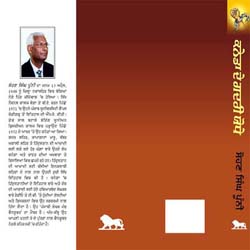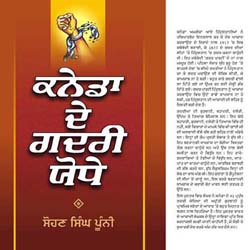South Asia Post: August 31, 2009
A new book on Gadarites by Sohan Singh Pooni suggests that the movement had its roots in Canada. Authored in Punjabi, Canada De Gadri Yodhay (The Gadar combatants of Canada) is the biographies of 41 freedom fighters of India, who were mostly associated with the Gadar Party, a revolutionary group that believed in armed struggle against the British occupation of India.
Though the group was formally established in America in 1913, the Gadar movement had its roots in Canada where the Indian immigrants had to endure racism. It was the discriminatory attitude of the Canadian establishment that partially made these men politically aware of the need to fight against the foreign rule back home.
 Most of these men came to Canada in the beginning of the twentieth century as British subjects. Their dreams for better living were shattered as the Canadian government systematically discriminated against them by restricting their immigration, family reunions and disfranchising them. As a result a need for struggle for both social justice and freedom arose. Gadar Party was therefore a byproduct of this abusive environment that motivated about 300 people in Canada alone to become members of this militant group, according to Pooni, who took nine years to complete his work. However, he could only write about 41 participants of the freedom struggle. Most of these men came to Canada in the beginning of the twentieth century as British subjects. Their dreams for better living were shattered as the Canadian government systematically discriminated against them by restricting their immigration, family reunions and disfranchising them. As a result a need for struggle for both social justice and freedom arose. Gadar Party was therefore a byproduct of this abusive environment that motivated about 300 people in Canada alone to become members of this militant group, according to Pooni, who took nine years to complete his work. However, he could only write about 41 participants of the freedom struggle.
His research took him to India and across the border, where he visited the archives and other places to lay hands on rare documents and pictures apart from interviewing the descendants of these men. Most biographies are accompanied by authentic pictures while some with portraits by Sheetal Anmol. Each chapter begins with verses from the revolutionary poetry written by the Gadarites. Niranjan Singh Pandori, Bhagwan Singh Preetam and Munsha Singh Dukhi were among those who had written the radical poems. The book includes their biographies.
Published by the Singh Brothers, Amritsar, India the book explains what shaped the ideology of the Gadar heroes. The common thread between these men was that they were mostly the rural Sikhs from Punjab some of whom had served in the British army. Most of them came to Canada as British subjects and were disillusioned by the fact that the British Empire was not treating all its subjects fairly. They had to pay heavily to travel to the British Canada. Initially, they tried to challenge the continuous journey law, the bar on bringing their families and the institutional racism through petitions and appeals but they realized soon that their slavery was the root of these problems and to end that an armed resistance was necessary. Subsequently, these men became the members of the Gadar Party that was officially launched in Astoria , USA . Most of them returned in a hope to initiate rebellion that was supposed to be the sequel of the Gadar (mutiny) of 1857 only to face gallows or life imprisonments.
 Among them were prominent ideologues like Bhag Singh, Tarak Nath Dass, Hussein Rahim, Harnam Singh Sahri, Balwant Singh Khurdpur, Karam Singh Daulatpur, Bhagwan Singh Dosanjh and Munsha Singh Dukhi. The book reveals their connection with Canada. Apart from leading the Gadar movement to set India free from the British rule these men participated in the community services in British Columbia. They not only established Sikh temples but also joint businesses of their own. Among them were prominent ideologues like Bhag Singh, Tarak Nath Dass, Hussein Rahim, Harnam Singh Sahri, Balwant Singh Khurdpur, Karam Singh Daulatpur, Bhagwan Singh Dosanjh and Munsha Singh Dukhi. The book reveals their connection with Canada. Apart from leading the Gadar movement to set India free from the British rule these men participated in the community services in British Columbia. They not only established Sikh temples but also joint businesses of their own.
Realizing that the misery of their compatriots in India was to be blamed on lack of education, they had helped in building schools in Punjab . Despite challenges from the orthodox and conservative social environment of India they had resolved to encourage female education. Some of them later turned into Babbar Akalis or communists while others were hanged or got killed otherwise.
Bhag Singh was the first Indo Canadian martyr, who was shot at by Bela Singh, the agent of an infamous immigration officer William Hopkison in 1914. He was the leader of the Khalsa Deewan Society that governed the oldest Sikh temple of Vancouver. He was instrumental in encouraging the former Sikh soldiers to burn their medals and certificates to break loyalties with the British Empire in 1909. This wasn’t an easy task as the Sikh preachers in India were pro British and prayed for the long life of their English masters back then. The book begins with his biography, which is followed by the profile of Badan Singh, who had also died with him after being hurt in the shootout. These killings were avenged by Mewa Singh, who assassinated Hopkinson and was hanged for the murder. His profile suggests that he may have done this at the instructions of the Gadar leaders.
The biography of Hari Singh Soond is also a part of the book. Soond had killed Bela Singh in India.
The book gives a detailed account of the activities of Hussein Rahim who was in the forefront of the fight for the right to vote besides the struggle to let the passengers of the Komagata Maru ship set foot on the Canadian soil. The ship was turned back on July 23, 1914 under the racist immigration law. This incident had added fuel to the fire and strengthened the foundation of the Gadar movement.
Harnam Singh Sahri was the cofounder of the Swadesh Sewak, the first Punjabi newspaper to be launched in Canada in 1910. While Pooni has done a good research on his activities, he failed to give the profile of the other cofounder of the publication, Guran Ditta Kumar. Kumar was another important ideologue. Though the book has some passing references about Kumar, but Pooni could have written more about him.
Despite being Sikhs, some devoutly religious the Gadar heroes mentioned in the book were liberal and secular. After all, one of the objectives of the Gadar Party was to keep the politics and the religion apart and promote unity. Some of these men who had returned to India had saved the Muslims from the Hindu and Sikh fundamentalists during the partition of India and Pakistan on religious lines in 1947. Among them were Chanchal Singh Jandiala, Bhagwan Singh Dosanjh and Sher Singh Vein Poin. These men did not buckle under pressure from the religious zealots and had helped the Muslims in reaching safe destinations. These details in the book will help in understanding the secular indoctrination of the Gadarites. The book ends with the biography of Darshan Singh Canadian, a communist leader of Punjab, who was murdered by the Sikh separatists in 1986. He had spent several years in Canada before India’s independence and had participated in the struggle for right to vote and different labour movements.
Very little is written about the Gadar movement and its participants by the mainstream historians, who had virtually ignored the contributions of the Gadarites. Perhaps, the perception about America being the breeding ground of the Gadar movement is also an outcome of this ignorance. Whatever little is available is based on oral history and interviews. More needs to be done to dig out credible evidence and documents. Pooni has tried to meet those challenges and his book has a potential to become an accepted document on the Gadar history. |